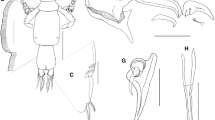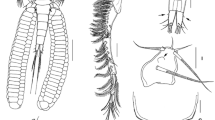Abstract
A new genus and species of cyclopoid copepod, Choreftria shiranui n. g., n. sp. (Crustacea: Copepoda) is described based on an adult female found from the worm goby, Taenioides snyderi Jordan & Hubbs (Actinopterygii: Perciformes: Gobiidae), from mud flats in the Yatsushiro Sea, southern Japan. The new genus is characterized by bearing the following characters in the female: body distinctly segmented cyclopiform with 4-segmented prosome and 6-segmented urosome; genital somite clearly separated from first abdominal somite; antennule 7-segmented; antenna 4-segmented with one fused serrated claw and long claw on second endopodal segment; mandible reduced with one serrated blade; maxillule rod-like with one element; maxilla 2-segmented with recurved terminal claw; maxilliped 2-segmented; legs 1 to 4 biramous with 3-segmented rami. Since the copepod is not attributable to any of the known cyclopoid families, a new family, Choreftriidae n. fam. is established to accommodate Choreftria n. g. LSID urn:lsid:zoobank.org:pub:C1FB9F60-9871-4D4B-A1BF-3202BA24189F.




Similar content being viewed by others
References
Avdeev, G. V. (1975). The first case of discovery of Lichomolgidae member (Copepoda, Cyclopoida) on a vertebrate animal from the region of Sri Lanka. Parazitologiya, 9, 202–204 (Russian with English summary).
Avdeev, G. V., & Kazachenko, V. N. (1986). Parasitic copepods from fishes of the genus Lophiomus Gill in the Pacific. Crustaceana, 50, 53–67.
Bocquet, C., & Stock, J. H. (1958). Copépodes parasites d'invertébrés des côtes de la Manche. IV. Sur les trois genres synonymes de copépodes cyclopoïdes, Leptinogaster Pelseneer, Strongylopleura Pelseneer et Myocheres Wilson (Clausidiidae). Archives de Zoologie Expérimentale et Générale 96, notes et revue 2, 71–89.
Boxshall, G. A., & Halsey, S. H. (2004). An introduction to copepod diversity. London: The Ray Society, 966 pp.
Boxshall, G. A., & O'Reilly, M. (2015). The first parasitic copepod from a scaphopod mollusc host. Systematic Parasitology, 90, 113–124.
Causey, D. (1960). Parasitic copepoda from Mexican coastal fishes. Bulletin of Marine Science of the Gulf and Caribbean, 10, 323–337.
Froese, R., & Pauly, D. (Eds.) (2021). FishBase. World Wide Web electronic publication. www.fishbase.org, version (06/2021).
Ho, J. S. (1967). Cyclopoid copepods of the genus Telson parasitic on Uranoscopid fishes in the Gulf of Mexico. Journal of Parasitology, 53, 852–858.
Ho, J. S., & Kim, I. H. (2004). A new genus of the Clausidiidae (Copepoda: Poecilostomatoida) associated with a polychaete from Korea, with discussion of the taxonomic status of Hersiliodes Canu, 1888. Proceedings of the Biological Society of Washington, 117, 95–105.
Ho, J. S., & Wardle, W. J. (1992). Pholadicola intestinalis, new genus and species, a clausidiid copepod parasitic in a deep-burrowing clam from Texas. Bulletin of Marine Science, 51, 37–44.
Humes, A. G. (1987). Copepods from deep-sea hydrothermal vents. Bulletin of Marine Science, 41, 645–788.
Humes, A. G., & Boxshall, G. A. (1996). A revision of the lichomolgoid complex (Copepoda: Poecilostomatoida), with the recognition of six new families. Journal of Natural History, 30, 175–227.
Humes, A. G., & Cressey, R. F. (1958). Copepod parasites of mollusks in West Africa. Bulletin de l'Institut Français d'Afrique Noire (A), 20, 921–942.
Humes, A. G., & Gooding, R. U. (1964). A method for studying the external anatomy of copepods. Crustaceana, 6, 238–240.
Humes, A.G., & Stock, J. H. (1973). A revision of the family Lichomolgidae Kossman, 1877, cyclopoid copepods mainly associated with marine invertebrates. Smithsonian Contributions to Zoology, 127, 1–368.
Humes, A. G., & Turner, R. D. (1972). Teredicola typicus C.B. Wilson, 1942 (Copepoda, Cyclopoida) from shipworms in Australia, New Zealand, and Japan. Australian Journal of Marine and Freshwater Research, 23, 63–72.
Huys, R., Fatih, F., Ohtsuka, S., & Llewellyn-Hughes, J. (2012). Evolution of the bomolochiform superfamily complex (Copepoda: Cyclopoida): New insights from ssrDNA and morphology, and origin of umazuracolids from polychaete-infesting ancestors rejected. International Journal for Parasitology, 42, 71–92.
Hwang, H. S., Lee, J. M., & Kim, I. H. (2016). Two new species of Clausidiidae (Copepoda, Poecilostomatoida) from Korea. Animal Systematics Evolution and Diversity, 32, 93–104.
Kim, I. H. (2001). Foliomolgus cucullus, a new genus and species of Clausidiidae (Crustacea: Copepoda: Poecilostomatoida) associated with a polychaete in Korea. Proceedings of the Biological Society of Washington, 114, 660–666.
Kim, I. H. (2007). Giardella ricoensis n. sp. from the West Indies and the proposal of the new genus Goodingius (Copepoda: Cyclopoida: Clausidiidae). Korean Journal of Systematic Zoology, 23, 127–133.
Kim, I. H. (2009). Poecilostome copepods (Crustacea: Cyclopoida) associated with marine invertebrates from tropical waters. Korean Journal of Systematic Zoology, Special Issue No.7. 7, 1–90.
Kim, I. H. (2015). Hamaticyclops ahni, a new genus and species of the family Clausidiidae (Crustacea, Copepoda, Poecilostomatoida) from California, United States. Animal Systematics Evolution and Diversity, 31, 304–310.
Kim, I. H., & Ho, J. S. (1991). Copepod parasites of commercial bivalves from Korea. I. Two new poecilostomatoid species from Solen grandis Dunker in the Yellow Sea. Korean Journal of Systematic Zoology, 7, 1–11.
Kim, I. H., Sikorski, A., O'Reilly, M. G., & Boxshall, G. A. (2013). Copepods associated with polychaete worms in European seas. Zootaxa, 3651, 1–62.
Kim, I. H., & Stock, J. H. (1996). A new species of Clausidiidae (Copepoda, Poecilostomatoida) associated with the bivalve Ruditapes philippinarum in Korea. Cahiers de Biologie Marine, 37, 1–6.
Moon, S. Y., & Kim, I. H. (2014). Description of Conchyliurus dispar n. sp. (Copepoda, Cyclopoida, Clausidiidae) associated with the bivalve Barnea manilensis (Philippi) from the Yellow Sea with a discussion of the male morphotypes in the genus. Zootaxa, 3760, 471–478.
Uyeno, D., & Rain, E. (2021). A new species of Pseudanthessius (Copepoda: Cyclopoida: Pseudanthessiidae) on Epinephelus sp. (Actinopterygii: Perciformes: Serranidae) from Chuuk Lagoon, Federated States of Micronesia. Species Diversity, 26, 249–254.
Wilson, M. S. (1957). Redescription of Teredicola typica C.B. Wilson (Crustacea: Copepoda). Pacific Science, 11, 265–274.
Wilson, M. S., & Illg, P. L. (1955). The family Clausiidae (Copepoda, Cyclopoida). Proceedings of the Biological Society of Washington, 68, 129–142.
Acknowledgements
I acknowledge Reo Koreeda (Kagoshima University) for providing the material, photograph, and biological information and Myles O’Reilly (Scottish Environment Protection Agency) for providing the valuable comments and kind corrections to improve the manuscript.
Funding
Part of this work was supported by the Japan Society for Promotion of Science (JSPS) KAKENHI Grant Number JP15H06517 and JP17K15304; “Establishment of Glocal Research and Education Network in the Amami Islands” project of Kagoshima University and “General and practical research for the restoration and creation of the natural environment in the Ariake Sea and the Yatsushiro Sea” project of Kumamoto University both adopted by the Ministry of Education, Culture, Sports, Science and Technology, Japan. Japan Society for Promotion of Science (JSPS),JP15H06517,DAISUKE UYENO ,JP17K15304,DAISUKE UYENO ,the Ministry of Education,Culture,Sports,Science and Technology, Japan.
Author information
Authors and Affiliations
Contributions
DU has carried out all the procedures in the preparation of the manuscript.
Corresponding author
Ethics declarations
Conflict of interest
The author has no competing interests to declare.
Data availability
See Material Examined section.
Additional information
Publisher's Note
Springer Nature remains neutral with regard to jurisdictional claims in published maps and institutional affiliations.
Rights and permissions
About this article
Cite this article
Uyeno, D. Choreftria shiranui, a new genus and species of cyclopoid copepod (Crustacea: Copepoda) associated with the worm goby from southern Japan, with the proposal of a new family. Syst Parasitol 99, 23–30 (2022). https://doi.org/10.1007/s11230-021-10013-5
Received:
Accepted:
Published:
Issue Date:
DOI: https://doi.org/10.1007/s11230-021-10013-5




